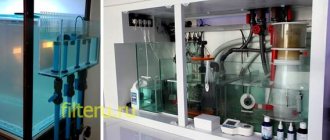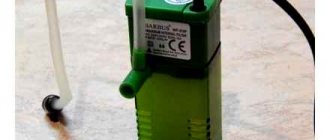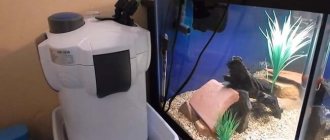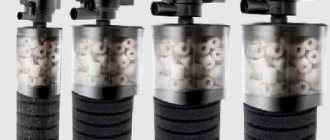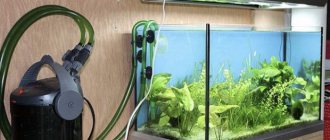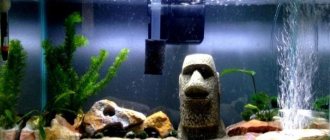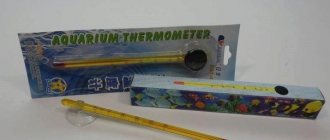To ensure that the water in the aquarium is always clear and suitable for fish to live in, it needs to be constantly cleaned. Purification is carried out using various filters - bottom, internal or external. The type of filter device is chosen based on the volume of the aquarium and the number of inhabitants. For larger aquariums, the Tetra Ex 800 Plus external filter is well suited.
The filter is placed outside the aquarium
Proper pump maintenance
The aquarist will need to not only correctly connect and install the internal filter, but also provide it with proper care.
Such equipment maintenance is performed at least once a week. It is necessary to regularly clean the filter sponge from dirt by rinsing it under running water. You should not turn off the electricity supply at night, as this can lead to the death of the fish. Before putting your hands in the water, be sure to turn off the pump. The filter should only work when completely immersed in water.
If these simple rules of equipment care are followed, it will last for many years, effectively purifying water and without causing any hassle during its operation.
Why do you need a filter in an aquarium?
The functions of an aquarium filter include mechanical and biological effects on water.
Mechanical cleaning refers to the retention of small solid particles, plant parts, feed residues, etc. If they remain in the aquarium for a long time, they decompose and the water becomes cloudy, which can result in poisoning of the inhabitants of the reservoir. Mechanical filtration is carried out using fine and large porous sponges.
Biological treatment is directly related to nitrifying microorganisms that are found on the soil, walls of the aquarium, decor, and most of them on the filter sponges.
These bacteria are the main participants in the nitrogen cycle in the aquarium: they convert dangerous ammonia, which is formed in the water during the life of fish, into nitrite, and then into absolutely harmless nitrate. If there are enough nitrifying microorganisms in the aquarium, all its inhabitants will feel as comfortable as possible.
Over time, organic residues accumulate on the filter hose and clog the pores of its sponges. In order to maintain the balance of the aquarium, it is necessary to periodically clean the filter.
Installation recommendations
Installing a filter in an aquarium is not particularly difficult; you just need to think about where such equipment will be located. Usually it is placed in a cabinet under the aquarium, for which the holes necessary for laying the hoses are drilled in the back wall of the furniture.
The filter will need to be assembled in full accordance with the instructions. All sponges and a special substrate for biochemical water purification are placed inside the filter. The aquarium has inlet and outlet tubes that must be under water. It is necessary to correctly install the filter in the aquarium, placing such equipment below the bottom level, which will ensure maximum efficiency of the pump.
The filter should be placed in its permanent place, and then using a mechanical hand pump, pump the system, trying to remove as much air as possible from the housing and pipes. A few presses of the hand pump will be enough, after which the water will flow by gravity through the inlet tube, squeezing the air out of the filter. As soon as the housing is completely filled with water, air will stop coming out of the outlet tube. After this, you can connect the equipment to the network and check its efficiency.
If the filter does not start or operates at minimum power, this indicates that the system is airy; accordingly, it will be necessary to remove air from the housing and tubes. To do this, with the filter turned on, press the hand pump button several times, which allows you to expel air from the system.
A small amount of air may remain inside the case, which will gurgle and make noise. To completely get rid of such small bubbles, you should carefully lift the filter and tilt it from side to side.
Having reached its full capacity, the device immediately begins to perform mechanical water purification. But biochemical filtration, when nitrates and nitrites are removed, begins approximately a month after the equipment is launched. During this time, colonies of nitrifying bacteria will settle on the substrate used, which are responsible for the chemical purification of water. That is why, if possible, fish should be stocked, especially demanding tropical species, a few weeks after installing an external filter in the aquarium.
Selection rules
The choice of external filter should be based on the characteristics of the aquarium. Before purchasing, it is advisable to study the parameters of the models offered in stores. Taking the time to learn about filter devices will help you make the right choice.
When purchasing, focus on the following parameters:
- Productivity means the ability of the device to pass a certain amount of water through itself in a set time. The power of the device is indicated on the packaging, measured in liters per hour (l/h). For an aquarium with a volume of 100-200 l, it is recommended to choose a filter with a capacity of at least 700 l/h.
- Noise – The outdoor filter may not be silent, but it should not be very loud.
- Build quality, availability of spare parts - the filter device is purchased for a long time, so you need to think about possible breakdowns and the possibility of repair.
- Manufacturer - on the market you can find many inexpensive little-known models for which sellers do not provide a guarantee, and service centers do not undertake repairs. It is better to buy a more expensive model, but produced by a reputable company. In this way, you can protect yourself from financial losses during the operation of the filter device.
How often should the external filter be cleaned and maintained?
The frequency of maintenance of the external filter is individual for each aquarium. The volume of water, the length of daylight hours, the type and amount of food - all these factors make their own adjustments and must be taken into account.
On average, the filter can be cleaned once every six months. The main signal to clean the filter is a decrease in the output flow by about half.
We recommend not waiting until the 50% drop in performance and cleaning before then, especially if you are experiencing algae deposits such as blackbeard.
It should be said that the filter only retains dirt on the sponges. When the filter is clogged, dirt remains in the aquarium water and slowly dissolves, causing the growth of all kinds of algae. If the aquarium is densely planted with plants that manage to “recycle” these substances, using them for their own growth, no problems arise, however, if there are not enough plants, the substances become food for algae, which will actively grow, bringing trouble to its owner in caring for the aquarium.
Tetra EX Plus range of external filters
author: fisher 01/15/2016 0 Comments
Filtration systems
Tetra
Tetra EX line of external filters includes three models of canister filters Tetra EX 600 Plus , Tetra EX 800 Plus , Tetra EX 1200 Plus , differing in performance. Having excellent design and excellent technical characteristics.
To keep fish and plants healthy, aquarium water must be constantly passed through a filtration system. Tetra EX filter technology allows you to reliably and safely remove excess organic matter from water, maintaining its high quality.
Tetra EX
range of external filters provides:
- crystal clear and safe water for fish, turning the aquarium into an unforgettable hobby
- allows you to quickly and easily clean filter media
- equipped with an incredibly powerful and quiet pump
- The kit includes everything you need for a quick and easy start, including all filter media
- includes a water pumping system to start the filter and valves for precise pressure control
The Tetra EX 600 Plus external aquarium filter provides effective water filtration in any aquarium with a minimum volume of 60 liters. The Tetra EX 800 Plus external aquarium filter provides effective filtration of water in any aquarium with a volume of at least 100 liters. The Tetra EX 1200 Plus external aquarium filter provides effective water filtration in any aquarium with a minimum volume of 250 liters.
Contaminated aquarium water is purified thanks to 5 different types of filter media. The water passes through ceramic rings, bio-balls, a traditional sponge, carbon media and a fiber pad, which remove various dirt particles and provide biological, mechanical and chemical filtration. Cleaning the filter and replacing fillers is made easier by the presence of convenient handles on each of the filter baskets. The drain tube and hose can be easily adjusted to suit any size of aquarium. Valves installed at the water inlet and outlet allow the water flow to be precisely adjusted to suit specific requirements. To clean, simply close the valves completely, then disconnect the adapter from the filter itself. In this case, the water remains in the hoses, which makes it possible not to pump it again the next time the filter is connected. Depending on the level of contamination and wear, filter media must be changed approximately every 6–12 months.
, the Tetra EX 1200 Plus canister filter is ideal for Natural aquariums measuring 90x45x45cm, and even 120x45x45cm (with a small number of slow-growing plants).
Good price/quality ratio; for its price it is a very convenient, and most importantly, filter of the required power.
For such a pump performance, the filter operates quite quietly. The noise it produces is comparable to the humming sound of the electromagnetic ballast of fluorescent lamps. To further reduce noise, the top cover of the motor block can be filled with padding polyester.
At the bottom of the canister there are four soft rubber feet that dampen vibration very well.
Filter power consumption is 21W.
The filter copes well with air trapped in the canister without blocking the pump.
The volume of the filter canister is 12 liters. With the baskets filled with filler, the water volume is 11 liters.
The canister contains four baskets for fillers with a volume of about 1 liter each, with very comfortable handles.
The kit includes all fillers, including activated carbon.
The filling in the lower basket is ceramic tubes. It is not very effective for biofiltration, but can be left to break up the flow and settle large particles.
It is recommended to place lava of the 5-10mm fraction in the remaining three baskets.
In the second basket from the bottom, you should first place a foam sponge, and on top of it there should be a 3cm layer of lava.
Bioballs (plastic lattice balls) are not used in this particular case.
Good priming pump, and priming is much more convenient than the Eheim ECCO. After two or three presses, water begins to quickly pour into the filter (reliability is a separate issue).
The internal diameter of the silicone hoses of this filter is 15.2mm. Their length is quite enough to install the intake and outlet pipes.
Unlike the green Eheim hoses, the original hoses are gray. It is believed that gray hoses are much less overgrown with algae inside.
It is very convenient that the block with taps is detached from the body (like the Eheim Professionel II and 3). The mechanism is convenient and reliable.
To prevent water from splashing out when disconnecting it, you should first close the inlet tap, and after 5-10 seconds. day off. The filter will be partially free of water and you can safely remove the block with taps.
The taps are very high quality and soft, which allows you to smoothly regulate the flow of water.
Be sure to tighten the hoses with union nuts - the hoses are too thick and do not fit deep, so they can easily come off!
The water flows into the aquarium with great force, so a flow diffuser like the ADA Lily Pipe Outflow is indispensable.
The main disadvantage of the filter is its weak housing. During operation, it “plays” a lot, which can cause a leak.
The filled filter is very heavy, so it is not recommended to carry it by the equally weak top handle. It is better to do this by grasping the filter under the handle ears on the sides of the canister.
Manufacturer's warranty - THREE years.
